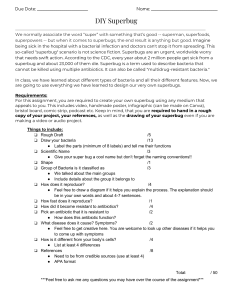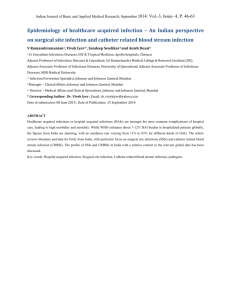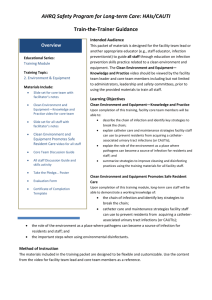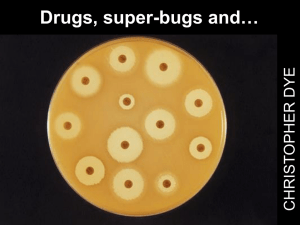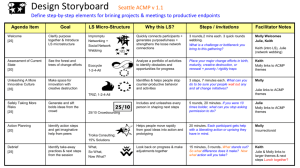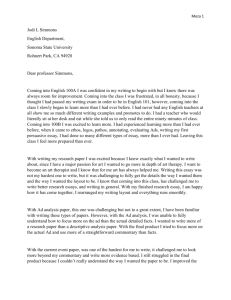Using Cultural Change to Control Superbugs
advertisement
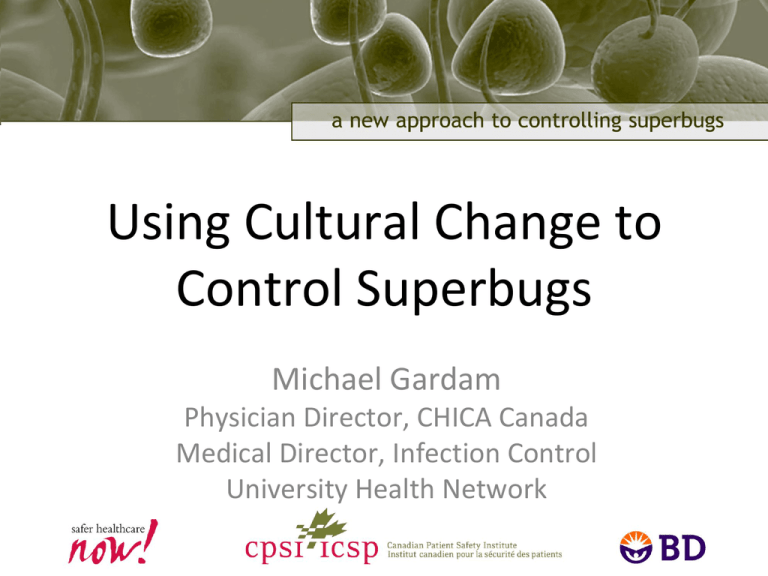
Using Cultural Change to Control Superbugs Michael Gardam Physician Director, CHICA Canada Medical Director, Infection Control University Health Network 1 Outline •Different problems require different approaches •Introduction to a New Approach to Controlling Superbugs •What we’ve learned Why a new approach? • Education, checklists, guidance documents are necessary but not sufficient • Tired to nagging • Tired of owning this problem • Traditional strategies don’t work well enough 3 “Insanity: doing the same things over and over again and expecting different results.” -Albert Einstein 4 The Hand Hygiene Hurdles 5 Current healthcare culture does not put a high value on infection prevention and control 6 What type of problem are you facing? Controlling superbugs is a complex problem 7 High Simple Complicated Complex Low Low Agreement Adapted from Brenda Zimmerman, 2010 High Simple or complicated problems • • • • • Search for solutions i.e. “fix it” Problem solve Checklists Algorithms Best practices 5 Complex problems • “Social immune response” – highly sensitive to local culture and conditions • • • • • No one size fits all Local solutions, multiple actions Allows for paradoxes Importance of relationships, intuition “minimum specifications” 10 The “minimum specifications” of infection control • • • • • Hand hygiene Environmental cleaning Surveillance (clinical, laboratory) Routine practices, additional precautions Appropriate antibiotic use If we do these well, our problems should largely go away… 11 Strategies • Simple/complicated problems may respond better to “top down” approaches • Complex problems may respond better to “bottom up” approaches • Infinite variations of both approaches 12 “Up, down and out” The NACS approach • Tackle behaviour and culture head on • Specific engagement of front line staff – Unusual suspects • Shifting of ownership from infection prevention and control to the front line • Use a variety of techniques referred to as “liberating structures” to achieve this – Positive Deviance is one liberating structure In any group… Increasing performance Some examples • • • • • Smoking cessation Medication reconciliation Malnutrition Gang violence and inner city youth Controlling healthcare associated infections 16 Key points • • • • Ideas come from those who are ”touching” the problem The group acts on ideas from “someone just like me” The groups succeeds and fails What works for one group may not work for another despite a similar challenge Reinventing the wheel • The role of infection control is to define the what the wheel needs to do…not how, or how fast, to build it Fewer infections Team 3 Team 1 Team 2 Superbug Tools • Sharing Stories • TRIZ • Improvisation • Discovery and Action Dialogues • Social Network Analysis • Wise crowds • 25 gets you 10 • 15% solution These tools allow you to • Clarify the problem • Improve participation • Unleash the ideas of those touching the problem • Notice patterns, common themes • Spread ideas • Sustain change TRIZ • Design a system whereby you can ensure that 100% of patients will be infected with a superbug within 2 days of admission to your facility 21 Discovery and Action Dialogues • 15-20 minute facilitated discussions with front line staff in their work setting • Different people will be at different sessions • Allow ideas to float to the surface 22 Who do you talk to about the prevention of superbugs? Legend RN External Clinical Educator Allied Health Director ICP Admin Housekeeping MD Executive Volunteer Resources Ward Clerk Patient Education Manager 23 Who do you want to work with in the future? Legend RN External Clinical Educator Allied Health Director ICP Admin Housekeeping MD Executive Volunteer Resources Ward Clerk Patient Education Manager 24 “It’s a lot easier for an organization to adopt new words than it is to actually change anything. Real change is uncomfortable. If it’s not feeling that way, you’ve probably just adopted new words.” -Seth Godin 25 Local innovations • Empty hand rub indicators • Disinfectant wipe brackets • New isolation carts • Videos • Antimicrobial stewardship • • • • • Point of care hand rub “green is clean” New signage Food tray shelves Staff and patient clothing hooks • Changes to bedside education • … 26 60.00 1.40 50.00 1.20 1.00 40.00 0.80 30.00 0.60 20.00 0.40 10.00 0.20 0.00 Soap used (L) per 1,000 patient days Alcohol gel used (L) per 1,000 patient days Incidence density of HAIs per 1,000 patient days 0.00 1 2 3 4 6000.00 0.40 0.35 5000.00 0.30 4000.00 0.25 3000.00 0.20 Number of boxes of gloves used per 1000 patient days Number of gowns used per 1000 patient days 0.15 2000.00 0.10 1000.00 0.05 0.00 Incidence density of HAIs per 1000 patient days 0.00 1 2 3 4 2 7 120.00 0.40 0.35 100.00 0.30 Soap used (L) per 1,000 patient days 80.00 0.25 60.00 0.20 Alcohol gel used (L) per 1,000 patient days 0.15 40.00 0.10 Incidence density of HAIs per 1,000 patient days 20.00 0.05 0.00 0.00 1 2 3 4 2 8 What we’ve learned • • • • • • • There is an appetite for a new approach Long term strategy/approach “failure to launch” Teams need more prodding Teams need to commit There are limits to virtual programs Coaching is crucial 29 “Culture Eats Strategy For Breakfast.” -Attributed to Henry Ford Will deviate for change • michael.gardam@uhn.on.ca • leah.gitterman@uhn.on.ca • positivedeviance.ca • stopsuperbugs.com • Twitter: @DrMichaelGardam
